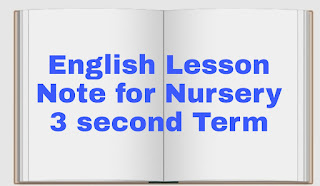English Lesson Note for Nursery 3 second Term
English Lesson Note for Nursery 3 - Second Term
Subject: English
Class: Nursery 3
Term: Second Term
Week 1: Introduction to Phonics
Objective: To introduce students to the sounds of English alphabets and basic phonics.
Activities:
Introduce the English alphabet to the students using flashcards or a chart.
Teach the students the sounds of each alphabet using simple words starting with those sounds (e.g., A for apple, B for ball).
Practice the sounds together as a class, encouraging students to repeat after you.
Play a phonics game where students have to identify the initial sound of various objects or pictures.
Provide worksheets or coloring pages where students can practice tracing the letters and matching them to the corresponding objects.
Week 2: Vocabulary Building
Objective: To expand the students' vocabulary and help them recognize and name common objects.
Activities:
Introduce a new set of vocabulary words related to everyday objects (e.g., table, chair, cup, spoon).
Use flashcards or real objects to show the students the objects and say their names.
Engage the students in a discussion about the objects, asking questions like "What color is the cup?" or "What can you do with a spoon?"
Play a memory game where students have to remember and name the objects shown to them.
Conduct a scavenger hunt in the classroom, where students have to find and name the objects you call out.
Week 3: Basic Sentence Structure
Objective: To teach students how to form basic sentences using subject-verb-object structure.
Activities:
Review the vocabulary words from the previous week and ask students to name the objects.
Model a simple sentence structure (e.g., "I see a cat") and explain the role of each word.
Encourage students to create their own sentences using the vocabulary words.
Use flashcards or pictures to create a story as a class, where each student adds a sentence to the story.
Provide worksheets with sentence frames where students can fill in the missing words to complete the sentences.
Week 4: Rhyming Words
Objective: To introduce students to rhyming words and develop their phonological awareness.
Activities:
Introduce the concept of rhyming words by providing examples (e.g., cat, hat, mat).
Play a rhyming word game where students have to identify words that rhyme with a given word.
Read rhyming storybooks or sing nursery rhymes that emphasize rhyming words.
Have students come up with their own rhyming words and share them with the class.
Create a rhyming word matching activity where students have to match words with similar sounds.
Assessment:
At the end of the term, assess students' progress by:
Conducting a phonics assessment where students have to identify the sounds of different letters.
Having students name objects or pictures and use the vocabulary words learned during the term.
Assessing students' ability to form basic sentences using subject-verb-object structure.
Evaluating students' understanding of rhyming words through a rhyming word activity or assessment.
Conclusion
Note: Adapt the activities and pace of the lessons according to the students' individual needs and abilities. Provide plenty of opportunities for hands-on learning and active participation to make the lessons engaging and enjoyable for the students.

Post a Comment